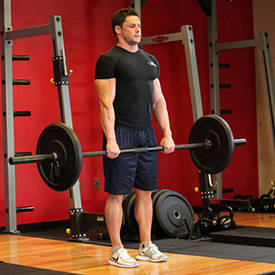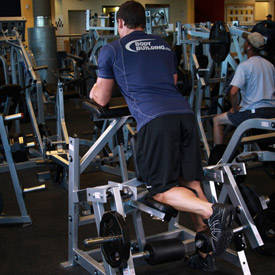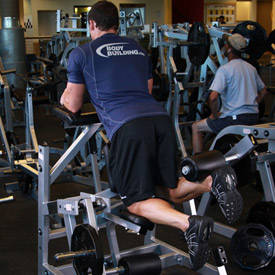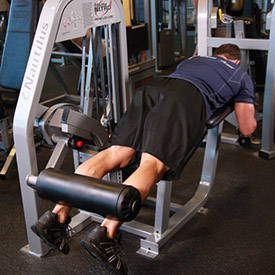By now, if you have been training for longer than a day then you know that you shouldn't take lightly the importance of leg training. No one wants to be the guy walking on the beach with the big upper body and walking around on what looks like toothpicks with shorts on. You need to hit the legs and you need to train them hard to make them grow.
Normally what happens is guys go in the gym to train legs and start with quads. After a few intense exercises there they move on to hamstrings. They will knock out a few sets for them and then decide to call it a day. This is not going to lead to balanced, muscular legs. If you are serious about training, then you need to pay better attention to the back of your thighs.
More About The Hamstring
The hamstrings cross and act upon two joints - the hip and the knee. The semitendinosus and semimembranosus extend the hip when the trunk is in a fixed position. They also flex the knee and inwardly rotate the lower leg when the knee is bent. The long head of the biceps femoris extends the hip as when beginning to walk; both short and long heads flex the knee and laterally outwardly rotates the lower leg when the knee is bent. The hamstrings play a crucial role in many daily activities, such as, walking, running, jumping and controlling some movement in the trunk. In walking, they are most important as an antagonist to the quads in the deceleration of knee extension.
When To Train Hamstrings
You can pay better attention to your hamstrings by training them one of three ways. You can either train the hamstrings first on leg day one week followed by starting with quads the next week. You can split leg day up by training quads or hamstrings in the morning and the other muscle group in the evening. Or you can train hamstrings on their own day. If you really want to improve the hamstrings, I recommend the latter suggestion. I am aware that scheduling doesn't always allow you to do that and you may need to train the entire legs in one day. If that is the case with you, go with one of the other two options.
Stretching And Warming Up Before Training
The last thing you want is a pulled or torn hamstring. Obviously stretching and warming up is crucial in all training, and training the legs is no exception. If anything, it is more important. Start by walking on the treadmill or riding the bike for about 10-to-15 minutes. Then go to a place where you have plenty of room to stretch out and loosen up.
Don't just stretch the legs either. Stretch the entire body including your core so you can train hard and be less likely to get hurt. Make sure you stretch in between some sets and after you finish with the weights as well.
exercise 1 stiff-legged deadlifts


Now we are ready to hit the iron. We are going to start with stiff legged deadlifts. Warm up with a bar with no weight on it. If you don't want to worry about your grip, you can use wrist straps. Grasp a bar using an overhand grip.
Stand with your torso straight and your legs spaced using a shoulder width or narrower stance. The knees should be slightly bent. This is your starting position. Keeping the knees stationary, lower the barbell to over the top of your feet by bending at the waist while keeping your back straight. Keep moving forward as if you were going to pick something from the floor until you feel a stretch on the hamstrings.
Exhale as you perform this movement. Start bringing your torso up straight again by extending your hips and waist until you are back at the starting position. Inhale as you perform this movement. Make sure you maintain looking straight ahead or up at all times. Looking down will put pressure on your neck and back and could lead to injury.
exercise 2 Standing leg curls


Standing leg curls are a great exercise for the hamstring as well as the glutes. You can do these at a cable station or your gym may have a specific machine for it. Hook your foot into the sleeves. Stand on whichever leg you think is stronger and lift the other leg in the air. Make sure you are standing straight and tall so you don't strain your back.
Brace yourself against something sturdy so you don't lose balance. Take a deep breath in. Bending at the knee, lift your foot up toward your glute and focus on contracting your hamstring. Exhale as you perform this portion. Slowly lower your foot back to the starting position and repeat.
Inhale as you lower your foot. Follow suit with the other leg when you finish with the first one. Perform three working sets of 15-20 reps for each leg wih two minutes rest in between each set. Now at this point, if you haven't stretched your hamstrings out during your training session, take a minute and do it now. This next exercise is going to be the most intense sets of the workout.
exercise 3 lying leg curl


Adjust the machine lever to fit your height and lie face down on the leg curl machine with the pad of the lever on the back of your legs just a few inches under the calves. Keeping the torso flat on the bench, ensure your legs are fully stretched and grab the side handles of the machine. Position your toes straight. This will be your starting position. As you exhale, curl your legs up as far as possible without lifting the upper legs or your hips from the pad.
Once you hit the fully contracted position, hold it for a second. As you inhale, bring the legs back to the initial position. Don't look around or up on this exercise as this places unnecessary stress on your neck and back. Keep your face down and just focus on contracting your hamstrings. Perform two sets of 15-20 reps with two minutes rest in between.
Once you rest after the second set, you will do a drop set where you perform a grand total of 50 reps. As you reach failure, lower the weight and count to five before resuming the exercise. Keep doing this until you reach the 50th rep. Afterward, stretch the hamstrings out again for a few minutes and walk for a few minutes around the gym or on a treadmill before leaving the gym.
Conclusion
Now that you hopefully have a new appreciation for the back of your thighs and you plan on training them harder, you will notice progress in a few weeks and will be well on your way to get those hamstrings growing. If you need a different routine after this one or if you have trouble understanding how to do these exercises, you can go to the exercise database at Bodybuilding.com to further study how to perform these lifts or find new exercises to implement into your leg training plan and ensure your hamstrings stay strong and growing.
